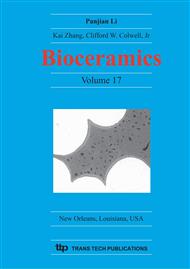[1]
Heimke G, Willmann G. Biomaterials Engineering and Devices: Human Applications, Humana Press Publ., Totowa, NJ, 1999, pp.223-51.
Google Scholar
[2]
Zeibig A, Luber H, Ceramics in surgery, Elsevier Publ. 1983 Amsterdam, pp.267-275.
Google Scholar
[3]
Andrisano AO, Dragoni E, Strozzi A. Proc Instn Mech Engrs, 1990; 204-H: 157-167.
Google Scholar
[4]
Middleton J, Pande GN, Richter HG, Willmann G. J Mater Sci: Mater Med 1994; 5: 503-506.
Google Scholar
[5]
Heimke G. Adv Mater 1994; 6: 165-70.
Google Scholar
[6]
Richter HG, Burger W, Osthues FG. Bioceramics 7. Butterworth Publ. 1994 pp.401-6.
Google Scholar
[7]
Richter HG, Willmann G, Wimmer M, Osthues FG. Modularity of orthopedic implants - STP 1301, ASTM Publ, 1997 West Conshohocken, pp.127-33.
Google Scholar
[8]
Willmann G, Brodbeck A, Richter HG. Bioceramics in Hip Joint Replacements, Thieme Publ, Stuttgart 2000, pp.81-7.
Google Scholar
[9]
American Society for Testing and Materials - Standard Specification for Bores and Cones for Modular Femoral Heads, ASTM F 1636, (1995).
Google Scholar
[10]
Calés B, Stefani Y. J Biomed Mater Res: Appl Biomater 1998; 43: 62-68.
Google Scholar
[11]
Hendrich C, Kaddick C, Pfaff HG, Willmann G. Bioceramics in Hip Joint Replacements, Thieme Publ. Stuttgart, 2000, pp.54-64.
Google Scholar
[12]
Dalla Pria P, Bregant L, Di Marino F. Performance of the Wear Couple BIOLOX forte in Hip Arthroplasty. Enke Publ, Stuttgart 1997, pp.136-8.
Google Scholar
[13]
Richter HG, Willmann G, Weick K. Alternative Bearing Surfaces in Total Joint Replacements - STP 1346, ASTM Publ, 1998, West Conshohocken, pp.173-185.
Google Scholar
[14]
Schäfer R, Soltétz U, Bernard PF. J Mater Sci Mater Med 1998; 9: 687-90.
Google Scholar
[15]
Sedel L. Surgical Techniques in Orthopedics and Traumatology, Elsevier Publ, 2001 Paris, S5-430-E-10.
Google Scholar
[16]
Medical Devices Agency. SN2002(05), February (2002).
Google Scholar
[17]
Willmann G, Clin Orthop 2000; 379: 22-28.
Google Scholar
[18]
Merkert P. Bioceramics in Joint Arthroplasty. Steinkoppf 2004, Darmstadt, pp.129-30.
Google Scholar
[19]
Pulliam IT, Trousdale RT, J Bone Joint Surg (Am) 1997; 79-A: 118-21.
Google Scholar
[20]
Garino JP. Bioceramics in Joint Arthroplasty, Thieme Publ. Stuttgart, 2001, pp.52-7.
Google Scholar
[21]
Garino JP. Clin Orthop 2000; 379: 390-7.
Google Scholar
[22]
Weisse B, Zahner M, Weber W, Rieger W. J Biomech 2003; 36: 1633-39.
Google Scholar
[23]
Hannouche D, Nich C, Bizot P, Meunier A, Nizard R, Sedel L. Clin Orthop 2003; 417: 19-26.
DOI: 10.1097/01.blo.0000096806.78689.50
Google Scholar
[24]
Piconi C, Labanti M, Magnani G, Caporale M, Maccauro G, Magliocchetti G. Biomaterials 1999; 20: 1637-46.
Google Scholar
[25]
D'Antonio J, Capello W, Manley M, Bierbaum B. J Arthroplasty 2002; 4: 390-7.
Google Scholar


